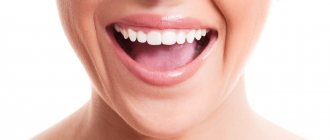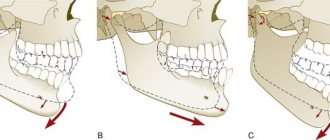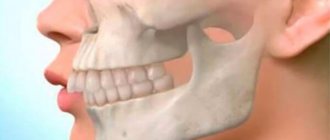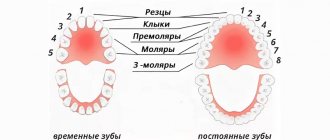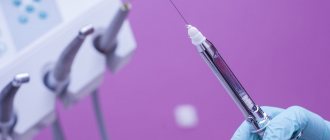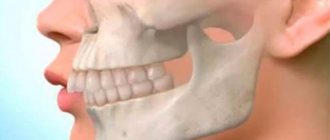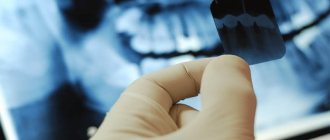Purpose of the dental system
The biological mechanics of the dental system and its understanding lead to timely recognition of pathologies of teeth and soft tissues of the oral cavity. The normal functioning of the temporomandibular joint largely depends on the structure and normal functioning of the periodontium - the soft tissues surrounding the tooth cavity.
The anatomy and physiology of the structure of the periodontium determines the biomechanics of the structure and the characteristics of the periodontium. In addition, periodontal biomechanics helps in the functioning of other organs.
Knowledge of the laws of biological mechanics of the jaw and joints helps to design and use features, as fundamental knowledge on the topic of prosthetics and dental implants. Knowledge of the anatomical features of the jaw is necessary in the manufacture of structures and dental materials.
Devices have been developed that almost completely repeat the movements of the jaw and make it possible to reproduce anatomically similar structures to the human jaw. Popular devices include the occluder, facebow, and articulator. The latter design plays an important role in the fitting and creation of individual prostheses.
If disorders of the lower jaw occur, disruptions in articulation, speech, nutrition and swallowing occur. Today, a system of articulation of movements has been developed, led by such authors as Ganau, Gisi, Monson. These authors most accurately described the biomechanics of mandibular movements.
The authors claim that dysfunction of the lower jaw, as well as sore neck muscles, necessarily lead to breathing problems. Different angles of inclination of the lower jaw determine human health.
Occlusion is a condition characterized by full contact of both jaws, which ensures complete chewing of food. Therefore, the contact of teeth is a determining factor for the characteristics of chewing mechanisms.
The work and action of the lower dentition during chewing is due to the synchronous work of all muscles and joints. The work occurs under the influence of the central nervous system. In this case, displacements that occur spontaneously occur under the influence of the neuromuscular structure.
Conscious movements of the dentition include the moment food enters the mouth and swallowing food. The remaining movements that occur after eating food are the result of unconscious motor functions of the body.
The lower part of the human masticatory apparatus is the only moving bone in the human body. However, the connecting and muscle tissue, which sets the mechanism in motion, is of great importance in the structure of the masticatory row and in the normal functioning of the muscles.
In the structure of the lower dentition, there are several muscle groups that are responsible for various movements of the jaw.
Clicking sounds when opening the mouth
The jaw clicks... More precisely, it clicks at the top of the lower jaw... Even more precisely, in the area of the branch of the lower jaw, closer to the ear. Clicks when opening and closing the mouth. How to get rid of clicking jaw?
Of course, the jaw itself cannot click. And such symptoms are a sign of dysfunction of the TMJ (temporomandibular joint), which is located in this area.
This joint is the area of attachment of the lower jaw to the skull (more precisely to the temporal bone of the skull). And ensures mobility of the lower jaw. It is this mobility that allows us to open our mouths for eating (chewing) and talking (singing, screaming). A click in the TMJ area is not a good sign. A sign (symptom) indicating that if left unattended, the same mobility of the lower jaw may, in the long term, be impaired.
Diagnostics is the first and key step in the treatment of clicking when opening the mouth. Do you want to know why it’s impossible to do without diagnostics?
In order to understand the mechanism of occurrence of such clicks, a brief excursion into the anatomy and biomechanics of the temporomandibular joint is necessary.
This joint is formed by the articular head of the lower jaw (10) and the articular fossa of the temporal bone. The fossa and the head are incongruent with each other, i.e. do not match in relief (shape). To “make friends” the surfaces of the fossa and the head (condyle), i.e. make them congruent to each other, at the top of the head there is an articular disc (2). It consists of cartilage tissue. And it has a biconcave shape, i.e. The disc cartilage is wider at its edges and narrowed in the center (this is important to remember!). The articular disc normally “accompanies” the articular head during movement of the lower jaw.
Temporomandibular joint.
But under certain conditions, for example, with distal occlusion, when the lower jaw is located posterior to the norm, the articular disc appears anterior to the articular head. Well, and, accordingly, it becomes an obstacle to its (head) movement. At first (at the beginning of the onset of dysfunction), while the ligament that returns the disc to its place still retains its elasticity, the disc becomes in the correct position when the mouth is opened. This “return” of the disk is accompanied by a noise effect in the form of a characteristic click. Because, as has already been said, the disk is wider at the edges than in the middle. And when the articular head “slips” through the wide edge of the disc, a noise (clicking) is produced.
Deflexion and Deviation. Trajectory of the lower jaw when opening the mouth with TMJ dysfunction.
It should be added that TMJ dysfunction is often accompanied by deviations of the lower jaw when opening the mouth to one side. And in the initial stages of dysfunction, when the articular disc is still capable of self-reduction, the return of the lower jaw to its normal trajectory is precisely accompanied by a click in the joint. This temporary deviation of the lower jaw is called deviation.
In later stages, the wide edges of the cartilage disc wear away, the ligament that returns the disc to its place weakens (loses elasticity) and the disc can no longer return back (to where it should be). Accordingly, the opening of the mouth is sharply limited (up to 2 cm when the norm is 4-4.5 cm). Since the disc, being an obstacle to the movement of the articular head, does not allow the lower jaw to make full-amplitude movement in the temporomandibular joint). At this stage, a persistent deviation in the trajectory of movement of the lower jaw when opening the mouth (deflexion) may already be observed. Which leads to misalignment of the jaw.
Well, then - more. The head (articular condyle), limited in movement and exerting pressure (compression) on the temporal bone (glenoid fossa), begins to collapse. The disk is destroyed too...
Arthrosis of the TMJ.
TMJ is normal.
And this is a completely different story, and different prospects (see “Crunch in the jaw”).
Treatment in installments
The Orto-Artel clinic offers installments for the entire process of treating any disease. Personal conditions are considered on an individual basis.
Find out more
or call 8 (495) 128-11-74
So it turns out that cracks in the jaw when opening or closing the mouth are the first, initial, but very formidable symptom. Indicating a developing pathology in the TMJ. And if there are similar clicks in the jaw, the patient should definitely not “click” and slow down. And it is necessary to contact specialists as quickly as possible.
It is best if these are specialists from the Orto-Artel clinic who have specific knowledge and extensive experience in treating clicking in the jaw when opening the mouth and preventing TMJ dysfunctions.
During a direct examination by a specialist, you will be able to find out your exact diagnosis, as well as receive a referral for diagnosis or a treatment plan.
Sergei Vladimirovich Yashin
author of the article
Dentist-orthodontist, maxillofacial orthopedist
More than 7 years of experience
Directions of movement of the lower jaw
During the movement of the lower jaw, sagittal, vertical and transversal displacement of its heads occurs.
Vertical displacement is necessary to open and close the mouth. In this case, the movement, depending on the force, occurs with varying strength, which determines the degree of movement of the head.
The sagittal axis of displacement is the ability to move the lower jaw back and forth. In this case, the forward movement of the jaw and the biomechanism of the head of the articular part at the moment of movement is called the sagittal path of the joints.
Transverse is the ability of the jaw to move left or right. In this case, certain muscle groups move. For example, the direction of the masticatory apparatus to the right determines the left direction of the lateral muscles, and vice versa.
Without knowledge of how muscles and joints work, the dentist cannot regulate the normal functioning of the masticatory apparatus, which means he will not be able to manufacture and install suitable dentures and implants.
Functional significance of the tubercles
The buccal cusps of the upper and lower molars, as well as the lingual cusp of the lower molar, perform a protective function. The palatal cusp of the upper molar is the supporting one.
In the process of closing the teeth in the central position, contact occurs between the palatal tubercles of the upper teeth and the central fossae or marginal projections of the molars and premolars of the lower jaw. There is also contact between the buccal tubercles of the lower teeth and the central fossae and marginal projections of the molars and premolars located above.
Note! The buccal tubercles of the teeth of the lower jaw and the palatine tubercles of the upper are supporting and holding ones. The lingual cusps of the lower teeth and the buccal cusps of the upper teeth are guides and protective (prevent biting the cheek and tongue).
When performing chewing movements, the lower jaw should slide over the surface of the upper jaw teeth without obstacles. The tubercles slide smoothly along the antagonist slopes without disrupting occlusal relationships.
At the same time, they must maintain tight contact. Sagittal and lateral movements are reflected on the surface of the first molars of the mandible by the arrangement of transverse and longitudinal fissures, this is called the “occlusal compass”.
Important! This landmark is necessary in the process of modeling the occlusal surface of the teeth.
During the movement of the lower jaw forward, the guide tubercles of the chewing teeth of the upper localization slide along the central fissure of the teeth located below. During lateral movements, gliding occurs along the fissure that separates the median buccal and posterobuccal cusps of the lower molar.
In the process of combined movement, gliding occurs along the diagonal fissure that divides the median buccal tubercle. The “occlusal compass” is characteristic of all teeth of the lateral group.
“Occlusal compass” - A and C - sagittal movements, B and E - transversal, D - combined.
Another important factor in the biomechanics of the lower jaw is the height of the cusps of the chewing teeth. This parameter determines the amount of initial joint displacement.
This is due to the fact that during the lateral movements of the lower jaw, the head on the working side moves outward before the rotational movements begin, while the head on the balancing side moves inward. This type of movement occurs within 0-2 mm.
The greater the flatness of the slopes of the tubercles, the greater will be the magnitude of the initial articular shift. This is how the free mobility of the dentition relative to each other within the boundaries of central occlusion is determined.
Note! In the process of modeling artificial teeth, it is very important to take into account the characteristics of the tubercles, as well as the inclinations of the slopes of the chewing teeth. Otherwise, disturbances in the interaction of the elements of the TMJ are possible, that is, the progression of joint dysfunction.
TMJ functioning problems
| Click to sign up for a FREE consultation |
Disruption of the work and function of the joints and muscles of the lower jaw is called TMJ dysfunction. The pathology is caused by the occurrence of a defect in the teeth, increased wear and tear and an abnormal bite of a person.
The main clinical manifestation of dysfunction is clicking and clattering of teeth when opening the mouth. In more advanced cases, pain occurs in the ears, jaw, and painful sensations begin during chewing and yawning.
The main method for diagnosing TMJ dysfunction is radiography, which reveals dysfunction of the jaw and joint.
Treatment consists of a comprehensive effect on the condition of the jaw, which the dentist carries out based on knowledge of the biomechanics of its work.

